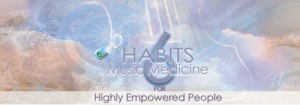
HABIT 4 – MUSIC HYGIENE
Extended Activities
Habit 4
Extended Activity 1
Notice what music is played in your environment (in or out of your control) and what your response is. How does it drive your life? Become consciously aware of three problematic responses to be proactive with prescriptive music listening.
Answer these questions about a typical situation – or remember a similar experience – to form personal insights about the music’s lyric, duration, and problematic mood. Ask these questions to yourself, and then ask the other person the same questions, to understand how three problematic responses tend to drive your life.
Situation
You’re riding in the car and your teenager demands certain music that completely unsettles you. Or, think of a similar situation with someone else and their choice of music.
#1 Problem Response – Mood
Do you find yourself crying or getting more agitated, anxious, or apathetic? What is your mood? What is their mood?
#2 Problem Response – Lyric
Is it the lyric or music, or both, that upset you? What is the lyric, and what does it make you think about?
#3 Problem Response – Duration
Do you turn it off before it finishes because you’ve had enough or do you push repeat because you want more? Does your upsetness build over time so that shorter durations would be tolerable, i.e. your teen’s music alternated with your choice of music?
The Difficult Conversation
Share your responses above with the other person and ask them the same questions to gain insight into their responses. Seek to understand why the other person wants to listen to that music now. Usually that type of difficult conversation can breed understanding and build empathy, thereby dissolving unhappiness.
For a deeper dive into understanding how music influences you analyzing eleven music elements effects on you, the Music Medicine Boot Camp training is available at MusicMedicineAcademy.com.
Habit 4
Extended Activity 2
Your desire to listen to music is guided by conscious and subconscious (instinctive) decisions. When you are conscious about music choices, your greater awareness of music’s effects can also uncover subconscious influences (reference Habit 3, Activity #4) that affect mental hygiene. Let’s dive into more states of consciousness that connect physiology to both the conscious and subconscious minds.
Brain wave activity occurs in these two states of consciousness.
These two types of music are found in music therapy and affect the above two states of consciousness.
Experiencing the alpha state of consciousness has been linked with the flow state, where you lose track of time and become unusually productive. Increasing the alpha state of consciousness has been found to significantly improve creativity, diminish anxiety and depression, improve pain tolerance and build resilience to stress.
Identify your music diet consumption.
Read more at https://themusic4life.com/does-your-music-diet-improve-mental-hygiene
Habit 4
Extended Activity 3
Leading expert on the psychology of exercise music, Costas Karageorghis asserts “Music can be legal, performance-enhancing medicine.” Learn about the physical influences of music that support decisions applying music prescriptively.
Identify four effects of music in three different styles that exert positive effects on physical activity for 3,599 participants engaged in exercise and sports activities.
Read “Music as Performance Enhancing Medicine” at https://themusic4life.com/music-as-performance-enhancing-medicine
Habit 4
Extended Activity 4
Follow a prescriptive approach that uses active music listening to analyze mood music for mental hygiene designations. Analyze your favorite music to decide their strength in making you feel specific moods, called U-Unsettled, S-Soothed and E-Energized, with the acronym USE music for health.
These three mood categories have these emotion assignments as seen in your self-assessments (Empowerment Habits 1 & 2).
Follow these tips to help you analyze your favorite music, respecting all genres, as “U”, “S”, or “E” moods. When music is a combination of these moods, set them aside for future considerations.
Four Analysis Tips
For more support learning how to categorize music, check out ecourses at MusicMedicineAcademy.com.
Habit 4
Extended Activity 5
A cleansing music diet includes the basic three Music Medicine playlists called U-Unsettled, S-Soothed and E-Energized.
Choose the music platform that makes it easy for you to access this powerful, portable command center, i.e. through your cell phone. Examples: iTunes, Spotify, Pandora, YouTube.
Create these three U.S.E. playlists on your desired music platform. Then populate music into these playlists with a balanced music diet perspective: comparable portions of music amongst the three playlists.
Start the day finding one new song to add to one of these playlists, guided by these suggestions.
This classification of music matching moods for Mental Hygiene (emotional cleansing) is the precursor to effective Emotion Regulation with one more essential step needed in Empowerment Habit #5.
Copyright 2022 Music 4 Life, Inc. All Rights Reserved.